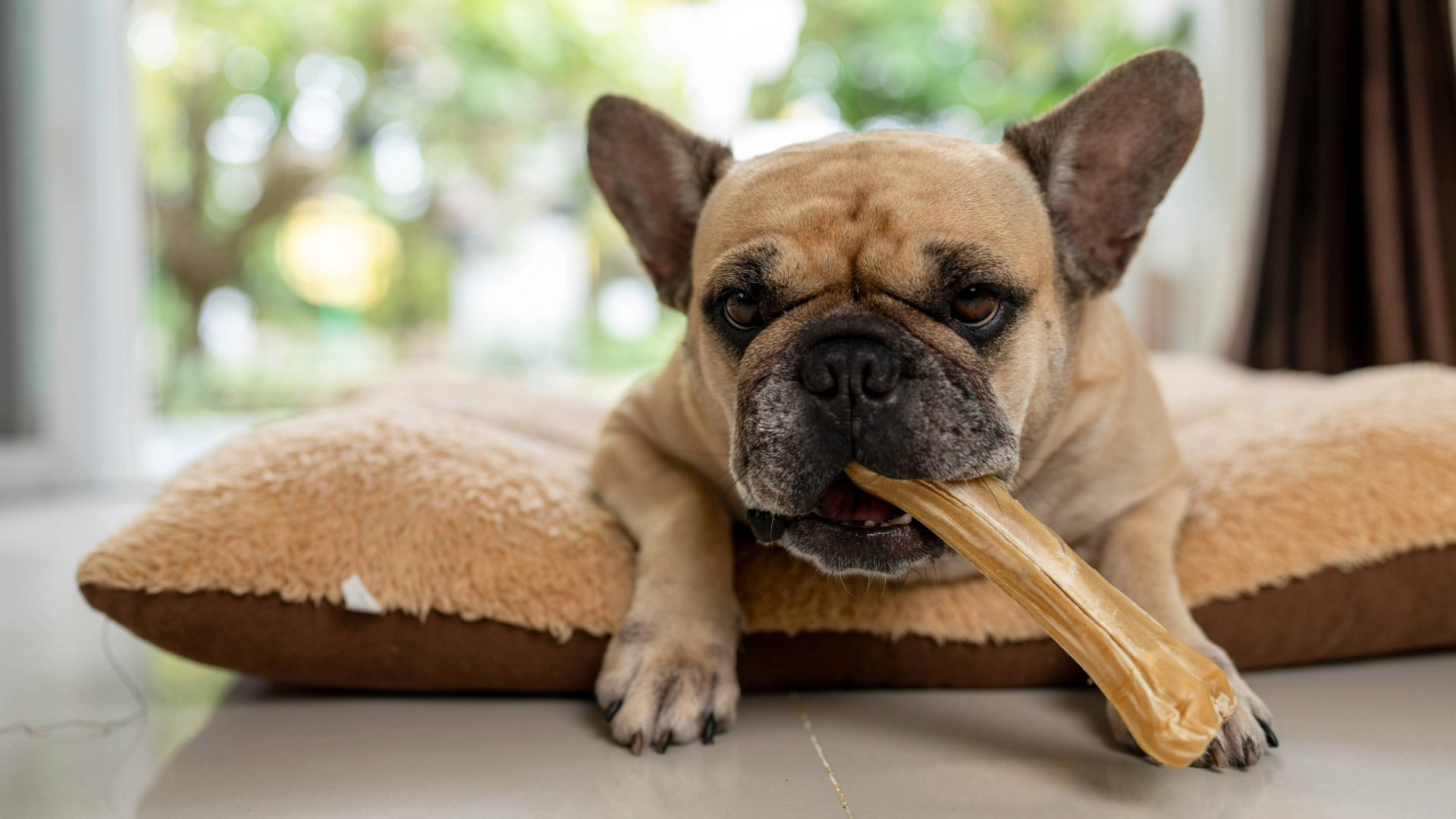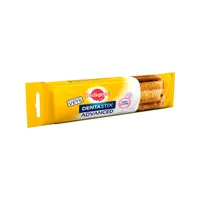Is rawhide bad for dogs? A vet weighs up the risks and benefits
Ever thought 'is rawhide bad for dogs?' We explain the pros and cons – and safer options to consider

You’re trying to do the best for your pup by providing them with mental stimulation when you suddenly think – 'wait, is rawhide bad for dogs?'.
When you’re hunting for the best long-lasting dog chews, you’re bound to come across some rawhide options – and now there are even options that proudly declare not to be rawhide. While rawhide used to be the go-to chew for dogs, it has somewhat fallen out of favor. So, what is rawhide, and is it really bad for dogs?
I’ve been a vet for nearly nine years and whether rawhide is bad for dogs is a common question I get asked. And the simple answer is – it depends. While I’ve never seen problems with it personally, I’ve certainly had colleagues with cases that turned out to be caused by problems with rawhide. Like everything, there’s always risks, and we’re going to go through them here so you can decide whether you will give your dog rawhide, or not.
What is rawhide?
Rawhide is processed animal skin – a by-product of the meat and leather industry – that’s then rolled and pressed into shapes. The manufacturing process – and the chemicals used – are a large part of the reason many people no longer feed rawhide, but there’s more to it, too.
Is rawhide bad for dogs?
Like I said, there’s no simple answer to 'is rawhide bad for dogs?' and every pet owner needs to make their own decision on this. So, let’s get right into it and give you the information you need with a pros and cons of rawhide for dogs:
👍Benefits of rawhide for dogs
- Helps to reduce boredom: Wild dogs and wolves are closely related to our domestic dogs, and many spend a lot of their time chewing at large bones, attempting to get to the marrow.
- Can reduce destructive instincts: Dogs are naturally inclined to chew, and if you don’t provide them with something to use (like rawhide), they’ll find something themselves – whether that’s a slipper or a table leg.
- May help clean teeth: Whether it’s rawhide or something else, chewing can help keep dogs’ teeth clean. It’s not perfect, and it depends how they chew, but tartar deposits are generally lower in dogs regularly given chew toys.

👎Risks of rawhide for dogs
- Choking hazard: The hard strips can be broken off into lumps, which are light and relatively easy to inhale, making them a choking hazard
- Gastrointestinal obstruction: When the rawhide is chewed, it sometimes comes off in big lumps. While these do soften in saliva (and gastric juices), the lumps can easily get stuck in the intestines, which may require surgery to fix.
- Chemical hazards: Rawhide processing can require a lot of chemicals. Depending where the rawhide is produced, these can include formaldehyde, bleaching agents, and glues.
- Food-borne illnesses: Batches of rawhide have been found to be contaminated with E. coli and Salmonella, which can cause problems for your dog and for humans they come into contact with, with outbreaks of Salmonella able to be traced to dried dog treats.
Read moreRead less▼
Pedigree Dentastix Advanced | Amazon
If you want to improve your dog's oral hygiene, these dental chews help remove plaque from the gumline and are approved by the Veterinary Oral Health Council.
Does rawhide break down in a dog's stomach?
While dogs can digest rawhide, how quickly this happens depends on the size of the pieces. A large knot of rawhide from the end of a rawhide ‘bone’ is unlikely to break down before it leaves the stomach and travels into the intestine, where it can lodge and cause an obstruction. On the other hand, small pieces (less than 2cm) break down in a dog’s stomach fairly quickly.
How to make rawhide safer for a dog
If your dog really loves rawhide and they aren’t fussed about other chews, you might decide it’s worth giving them rawhide. In this case, there are things you can do to make the rawhide safer.
Get the best advice, tips and top tech for your beloved Pets
Firstly, try to buy your rawhide from reputable brands, who manufacture their products in the USA, Canada, or Europe. These are less likely to be chemical-heavy than mass-imported versions that have no brand on the packaging.

Secondly, observe your dog’s chew style. If they’re likely to break off large bits and swallow them, find them pieces of flatter rawhide or a tight ball of rawhide, rather than a ‘bone’ with two balls separated by a thin strip. This thin strip can easily be bitten through and each ‘ball’ becomes a hazard.
Thirdly, always watch your dog when they’re eating rawhide, so you can anticipate and prevent problems. If you spot any of the following symptoms, make an appointment with the vet for a check over:
- Coughing or hacking
- Pawing at the mouth or throat
- Retching or vomiting
- Diarrhea
- Not wanting to eat
- Listlessness or lethargy
Do vets recommend rawhide?
In general, I don’t recommend rawhide to pet owners. Between the chemicals and the risk of obstruction, I don’t think rawhide is safe enough for most dogs, and there are some good safe alternatives. For inspiration and further guidance, read our guide on the safest dog chews for aggressive chewers.
You might want to try nylon-based bones, milk-based bones, braided tendons/meat, or skin that is rolled and baked without all the chemicals. You should still be careful of a risk of obstruction if your dog is likely to tear off chunks of any chew, and understand that both chews come with a risk of dental fractures.
A stuffed rubber Kong toy (like this one from Amazon) also makes a good, safe option, but doesn’t always work, depending on a dog’s chewing style.
So, the answer to ‘is rawhide bad for dogs?’ is it depends! Thousands of dogs consume rawhide with no problems, but the risk of obstruction is high (especially with some shapes) and they may not be the healthiest of dog chews.
There are lots of alternatives on the market, and finding one that suits a dog should be possible. If your dog does really enjoy rawhide though, and you can’t find a safer alternative, the benefits might not be worth losing – use the ways to make rawhide safer, outlined above.
Read next: Rawhide vs beefhide, can dogs chew corn cobs, why is my dog chewing rocks and what are bully sticks made of?

After graduating as a vet from the University of Nottingham in 2016, Dr. Joanna Woodnutt went on to practice companion animal medicine in the Midlands. She quickly developed a love of consulting and helping clients with medical problems such as dermatology, behavior and nutrition - anything that involved helping clients understand their pets better.
Edited by Megan Milstead.
This page was last updated in June 2025 by Joanna Woodnutt.
After graduating as a vet from the University of Nottingham in 2016, Dr. Joanna Woodnutt went on to practice companion animal medicine in the Midlands. She quickly developed a love of consulting and helping clients with medical problems such as dermatology, behavior and nutrition - anything that involved helping clients understand their pets better.
Jo started writing about pet health in 2017, realizing that it meant she could help even more pet parents. Since then, she has written for countless online and print publications and is a regular contributor for Edition Dog Magazine. Jo is the director of The Veterinary Content Company, which she founded in 2020. She is also the founder of Petlearnia, a platform that provides pet e-learning courses for pet parents.
Jo now lives in the Channel Islands with her husband Ian and terrier Pixie.

